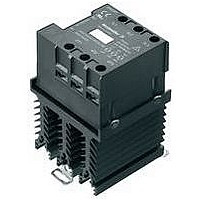8952130000 Weidmuller, 8952130000 Datasheet - Page 4

8952130000
Manufacturer Part Number
8952130000
Description
SSR, DIN RAIL, 520VAC, 30VDC/30VAC, 20A
Manufacturer
Weidmuller
Datasheet
1.8952110000.pdf
(142 pages)
Specifications of 8952130000
Control Voltage Type
DC
Control Voltage Range
8VDC To 30VDC / 10VAC To 30VAC
Operating Voltage Range
24VAC To 520VAC
Peak Surge Current
250A
Load Current
20A
Switching Mode
Zero Cross
Rohs Compliant
No
C
Relays – overview
Relay couplers – an overview
Historical background
The term ‘relay’ was originally used for a station where stageco-
aches were able to change their tired horses for fresh ones. The
term ‘relay’ was given a totally different meaning by the English
physicist Charles Wheatstone (1802–1875). In Wheatstone’s ti-
mes, departing trains were signalised by a ringing bell at the next
railway station up the line.
This was achieved by connecting a battery in the first station to a
bell in the second. However, as the railway stations were gene-
rally several kilometres apart the power arriving at the second
station was often insufficient to ring the bell. Wheatstone inven-
ted a switchgear apparatus that was installed at the second rail-
way station. This continued to function even with low power
supply levels. The switchgear apparatus switched a second el-
ectrical circuit that actuated the bell. That was the birth of the el-
ectromagnetic relay.
How a relay functions
A relay is an electromagnetic switch comprising two galvanically
isolated circuits. Firstly the control circuit and secondly the open
circuit with the normally open contact. As soon as the control
circuit is energised, the coil creates a magnetic field in the
core/yoke and attracts the armature. The actuator now actuates
the switch at the output, the normally open contact (make
contact) closes and the normally closed contact (break contact)
opens. When the control circuit is turned off, the magnetic field
diminishes and the return spring returns the armature to its initial
position. The actuator moves the normally open (make contact)
back to its normal position, the normally open contact opens,
the normally closed contact (break contact) closes.
C.4
a
Isolation
u r
Relay base
A1
Actuator
Yoke
Coil
Coil
Core
A2
Armature
Armature
return
spring
Consequently, with low power input – battery power for example
– a relay provides the option of switching heavy loads as well as
being able to serve as a switching amplifier. Thanks to the isolati-
on between the input and output, relays are also suitable for pro-
viding separation when the power of the control and the open
circuits differ. Equipped with several NO (make) contacts, a relay
can also be utilised for multiplying signals.
From relay to relay coupler
There are two alternative methods that make a relay coupler sui-
table for use in industrial applications: mounting onto a PCB – in
combination with the corresponding assembly techniques and
circuitry – or plugging onto a specially designed relay base.
Generally, the design and rating data determine if a relay coupler
is or is not suitable for a particular application.
For example, relay couplers with plugged on relays are only part-
ly suitable for use in applications subjected to heavy vibrations.
In this case, relay couplers with soldered relays should be prefer-
red. Low, compact designs such as those provided by the RI-
DERSERIES are utilised in small consumer units where the over-
all available height is limited. Conversely, the compact design of
the MICROSERIES helps to save space in electrical cabinets.
Protective separation
It is essential that all electrical equipment required to provide
protective separation be designed in such a manner that the in-
sulation cannot be impaired, for example by mechanical errors. If
a mechanical error occurs in a relay (bent soldering pin, broken
winding wire or broken spring), ‘protective separation’ must be
guaranteed. Relays are specified and tested in accordance with
EN 61810-1. However, the standard makes no reference to EN
50178 (Electronic equipment for use in power installations);
equally no definition is given for the term ‘protective separation’.
Things are made worse by the fact that different measurement
conditions are given for the test voltages stipulated for relays.













